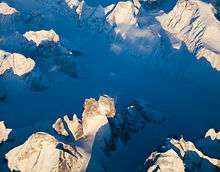Mount Asgard
| Mount Asgard | |
|---|---|
 Mount Asgard in July 2001 | |
| Highest point | |
| Elevation | 2,015 m (6,611 ft) [1] |
| Coordinates | 66°40′20″N 65°16′28″W / 66.67222°N 65.27444°WCoordinates: 66°40′20″N 65°16′28″W / 66.67222°N 65.27444°W [1] |
| Geography | |
| Location | Nunavut, Canada |
| Parent range | Baffin Mountains |
| Topo map | NTS 026I/11 |
| Geology | |
| Mountain type | granite |
| Climbing | |
| First ascent | 1953 by J. Weber, J. Marmet, H. Röthlisberger |
| Easiest route | technical rock climb (Grade IV, YDS 5.8/5.9, A1) |

Mount Asgard is a twin peaked mountain with two flat-topped, cylindrical, rock towers, separated by a saddle. It is located in Auyuittuq National Park, on the Cumberland Peninsula of Baffin Island, Nunavut, Canada. The peak is named after Asgard, the realm of the gods in Norse mythology. Mount Asgard is perhaps the most famous of the Baffin Mountains.[2]
Climbing history
Asgard's slightly higher North Peak was first ascended in 1953 by J. Weber, J. Marmet, and H. Röthlisberger, Swiss scientists on the Arctic Institute Baffin Island Expedition, led by the Canadian P. Baird.[3] Their route ascended the east side of the north peak, using a climbing traverse across snowfields and rock ribs, to reach the saddle between the two peaks, and thence to the top of the North Peak. The route is graded VI, 5.8/5.9 A1. It is still the most-traveled route and is the standard descent route for climbers making harder ascents on other faces.[4]
The South Peak was first climbed in 1971 by G. Lee, R. Wood, P. Clanky, J. Pavur, Y. Kamisawa and P. Koch. Since then, at least 13 routes have been put up on the two peaks, most involving highly technical free and aid climbing, with lengths varying from 800 m (2,600 ft) to 1,200 m (3,900 ft). One of the most notable routes was put up in 1975 by Charlie Porter as a solo climb. This was "the first Baffin modern, multi-day, technical, big-wall climb", with 40 pitches rated at Grade VII, 5.10, A4 and it was followed by "a 10-day walk-out to the fjord-head without food". The fact that this was all done solo was "a remarkable achievement".[4]
In 1976, stuntman Rick Sylvester performed a BASE jump, skiing off the mountain with a Union Flag parachute for the opening sequence of the James Bond film The Spy Who Loved Me, although the fictional setting was the Austrian Alps. The stunt team and film crew had reached the summit by helicopter.
See also
References
- 1 2 "Mount Asgard". Bivouac.com. Retrieved 2009-05-23.
- ↑ "Baffin Island". Peakware World Mountain Encyclopedia. Retrieved 2007-11-02.
- ↑ "Canadian/Swiss Baffin Island Expeditions, 1950 and 1953". Swiss Foundation for Alpine Research. Retrieved 2008-01-03.
- 1 2 Doug Scott, "Mount Asgard", in World Mountaineering (Audrey Salkeld, editor), Bulfinch Press, 1998, ISBN 0-8212-2502-2.
External links
| Wikimedia Commons has media related to Mount Asgard. |